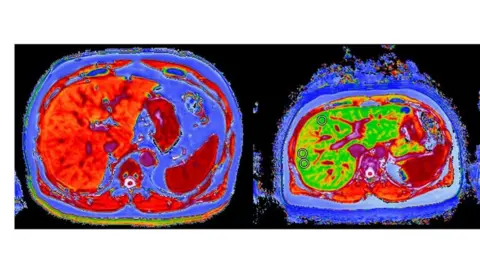'Wake-up call' over liver disease risks due to weight
One in eight middle-aged adults in the UK could have a potentially serious form of liver disease - because they are overweight.
Scans of nearly 3,000 individuals from the UK Biobank research project showed that 12% had inflamed, fatty livers.
The British Liver Trust said the "very alarming" findings were a 'wake-up call' because the condition can lead to cirrhosis, liver failure and death.
Hepatologists said there was a silent epidemic of fatty liver disease.
This is especially worrying because symptoms often do not emerge until permanent damage is done - but the condition is reversible if caught in time.
Back to normal
Frances Carroll, aged 52, from Oxford, was told she had fatty liver disease seven years ago.
At the time she weighed over 18 stone (116 kilos).
She lost 7 stone, and went down from a size 22 to a 12.
Frances said: "I was shocked when I was told my liver was diseased, but determined to do something about it. I started by eating more healthily and then combined that with physical activity - I'm delighted my liver is back to normal."
Frances now teaches fitness classes and does nutrition coaching.
She said: "Back in 2011 I would not have believed that I would end up as a personal trainer. I used to get out of breath when I walked any distance - now I run up hills!"
And she has had a new type of MRI scan which has showed her liver is healthy again.
The results of the MRI scanning study, led by scientists in Oxford, were announced at the International Liver Congress in Paris.
They were made possible by an innovative software analysis tool called LiverMultiScan, developed by Perspectum Diagnositics, a spin-out company from the University of Oxford.
Dr Rajarshi Banerjee, CEO of Perspectum Diagnostics said: "LiverMultiScan is a great example of a smart health technology discovered and developed by UK clinicians and scientists with clear benefits for patients, the NHS, and taxpayers.
"Whilst liver biopsy remains an important part of hepatology practice, clearly we need better non-invasive tools at our disposal to evaluate the nature and severity of liver disease."

 Perspectum Diagnostics
Perspectum DiagnosticsNeedle biopsies are the gold standard for assessing liver disease, but they are costly, invasive, painful and carry some health risks.
The software tool can be used in any MRI scanner but is not yet in routine clinical practice.
Southampton General is the first NHS hospital to use the new system outside of research.
David Breen, associate professor of radiology at University Hospital Southampton believes it could reduce the need for biopsies.
He said: "The scan gives a map of the entire liver as opposed to a needle-core biopsy which samples just one area and can be unpleasant.
"It also allows us to re-scan patients over time and see if they improve."

Previous studies had suggested that around one in 20 adults might have the potentially serious form of fatty liver disease known as NASH (non-alcoholic steatophepatitis).
This is where there is inflammation in and around the liver cells liver which, over time, can can lead to the build up of scar tissue known as fibrosis - eventually this can lead to cirrhosis.
But the scanning study suggests the proportion could be much higher.
Steve Ryder, consultant liver specialist in Nottingham said: "This study accords with what we are seeing on the ground - a lot of people are coming to hospital with significant liver disease because they are overweight."
Ninety per cent of liver disease is reversible if caught in time.
Judi Rhys, chief executive of the British Liver Trust said: "Reducing alcohol is important which most people already know, but for fatty liver disease the key things are having a healthy weight and doing exercise."
The charity has an online screening tool to assess your risk of liver disease.
Follow Fergus on Twitter
